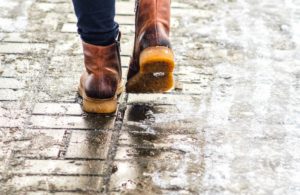By: Jeffrey Hall
In a decision approved for publication, the Appellate Division decided the case of Pareja v. Princeton International Properties,___N.J. Super___ DOCKET NO. A-2111-18T3 (App. Div. April 9, 2020). This decision lays to rest the long-standing notion that the so-called “ongoing storm rule” protected commercial property owners from liability from slip-and-fall claims that arise from falls occurring during winter storm events. The ongoing storm rule stood for the proposition that a commercial property owner owed no duty to the public to protect persons from slips and falls during a winter storm event. This decision should have a ripple effect as it will require owners to align snow and ice clearance procedures to provide for removal and mitigation measures during storms whenever such measures are not impracticable. An owner that fails to do so could see an increase in insurance premiums if its lack of diligence leads to more slip and fall incidents on its property.
In rejecting the ongoing storm rule, the Appellate Division stated uncategorically that its bright line test was not appropriate and was actually contrary to sound tort principles of promoting deterrence because it discouraged property owners from “act[ing] in a reasonably prudent manner under the circumstances to remove or reduce the foreseeable hazard”. The facts facing the Court were straight forward and uncomplicated. It was early January and had been cold for several days. There had been ongoing storm events for several days with traces of snow on the ground and temperatures persisting at 32 degrees or lower. There were piles of snow at street corners from plowing activities. Importantly, the weather advisory predicted some frozen precipitation in the form of snow or sleet to occur the night before.
The property was a relatively small commercial property with a three-story building. Two offices were on the first floor and two apartments occupied the second and third floors. Overnight, the owner’s vice president had been monitoring the weather and noted the overnight prediction of frozen precipitation. That morning, its maintenance supervisor had observed that the streets in the vicinity of the property were slippery. The injured individual arrived at work at approximately 7:50 a.m., just as the business day was starting. Walking from his car, he slipped on black ice on the driveway apron and suffered severe injuries. The inevitable law suit followed but his claim was extinguished when the defendant successfully obtained a summary judgment from the trial judge.
In reversing the judgment, the Appellate Division rejected the ongoing storm rule and stated that these slip and fall cases during winter storm events would be evaluated using “reasonableness as the pole star”. The question of liability will arise after the commercial property owner has either constructive or actual notice of conditions which bring to fore a duty to take action to mitigate the dangerous condition that results. The Court was quick to point out that the owner will not have “absolute” liability during the course of a storm; rather, whether action was “inexpedient or impracticable” will be a question for the jury in a subsequent law suit. Thus, when a property owner fails to act in such circumstances, such failure will always be a question for the jury.
In arriving at this decision, the Appellate Court surveyed existing law throughout the United States and observed that there was a split in these decisions. Some state courts found that the ongoing storm rule was inappropriate and applied a test that depended on the circumstances confronting a property owner. However, other states held fast to the ongoing storm rule observing that it was both inexpedient and impracticable for an actor to attempt to mitigate slippery conditions during the storm. The Appellate Division, in surveying these cases, noted that a jury was capable of a common sense review of the facts and would undoubtedly reject liability when a storm was so fierce that mitigation efforts during its course would be futile.
In reaching this decision, the Appellate Panel applied the four-part test articulated by the New Jersey Supreme Court in Hopkins v. Fox & Lazo Realtors, 132 N.J. 426 (1993). The four Hopkins factors as established by the Court are:
- The relationship of the parties;
- The foreseeability and nature of the risk of harm;
- The opportunity and ability to exercise care; and
- The public interest.
In evaluating these four factors, the Appellate Division came down squarely in favor of rejecting the ongoing storm rule bright line test in observing that notions of fairness and common sense should prevail. Thus, it concluded that during a winter storm “it is fair to impose a duty of ordinary and reasonable care on commercial land owners because – under all the circumstances – they are well positioned to remove or reduce foreseeable known snow and ice hazards.”
In the end, the Court held that “a commercial land owner has a duty to take reasonable steps to render a public walkway abutting its property, covered by snow or ice, reasonably safe, even when precipitation is falling.” Such liability will arise only if the land owner fails to act in a reasonably prudent manner to remove or reduce the hazard after it has actual or constructive notice. While there is no absolute liability for every slip and fall injury, “the duty of ordinary care requires nothing more than expecting a commercial land owner to act in a reasonably prudent manner under all of the circumstances.” In a final note, the Court stated that “reasonableness” is “generally” a jury question. It then outlined eight considerations that a jury should take into account which was a summary of its reasoning. Importantly, one of those considerations was whether the conditions made it so hazardous that it would be unsafe for the land owner or its contractor to venture out into the elements to attempt mitigation.
At the time of writing this article, it is not known whether the defendant will appeal to the New Jersey Supreme Court for review of this decision. If it does not, or until such times as it does, this decision is the law in New Jersey.
To be in compliance, commercial property owners should take the following steps. First, review their procedures for snow and ice removal. If the procedures require removal only at the end of a storm event, they should be changed. Second, check the contracts they have with their snow removal contractors. Consider inserting a clause requiring the contractor to actively respond to ongoing winter precipitation events. Third, monitor the inclement weather carefully and establish a procedure for immediate contact with the contractor if adverse surface conditions are predicted. In the end, the commercial property owner should seek to provide the public with safe conditions whenever feasible.
Jeffrey Hall is of counsel with the Lawrenceville, NJ law firm of Szaferman, Lakind. He can be reached at 609-275-0400 or via email at jhall@szaferman.com.






